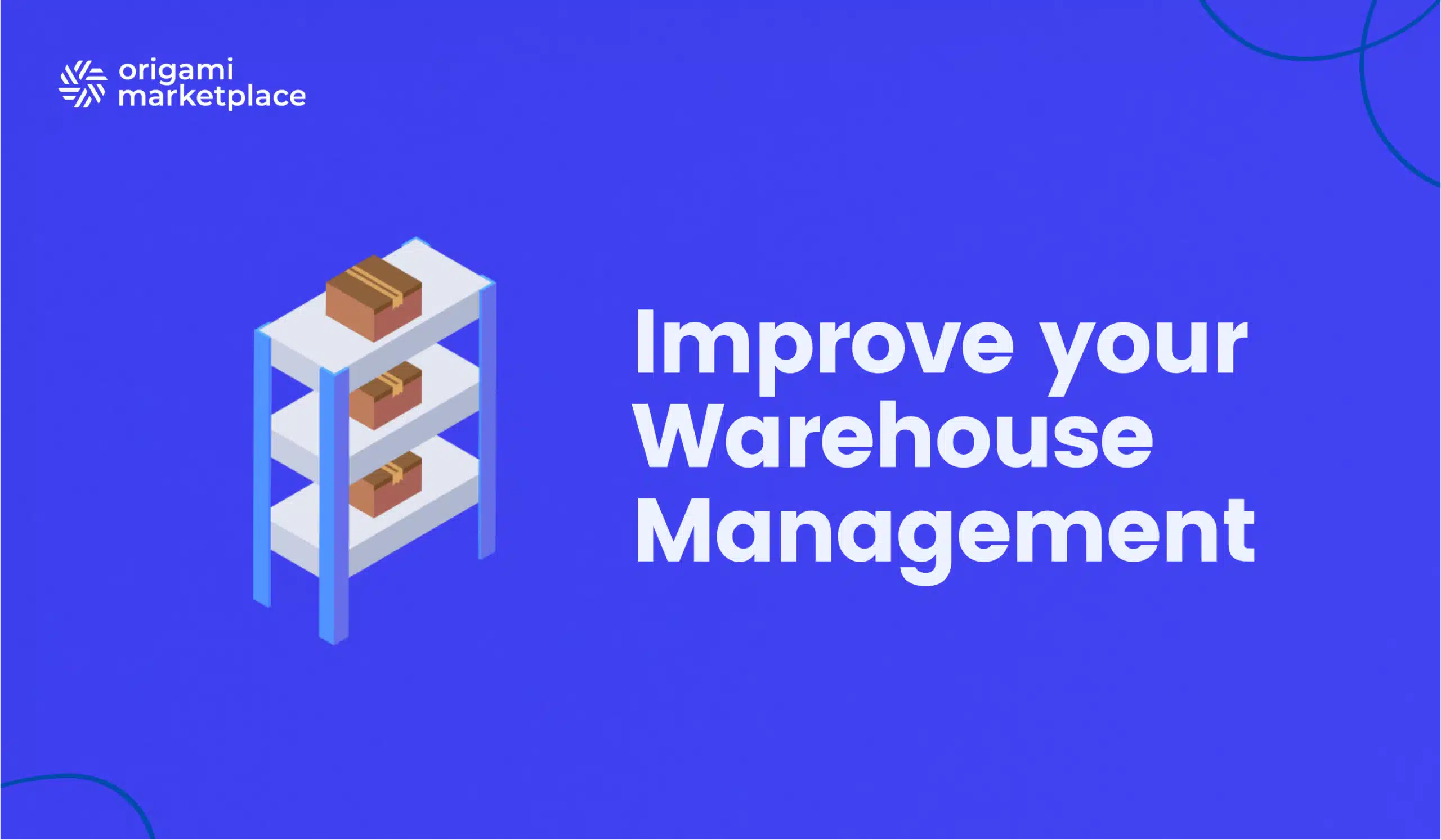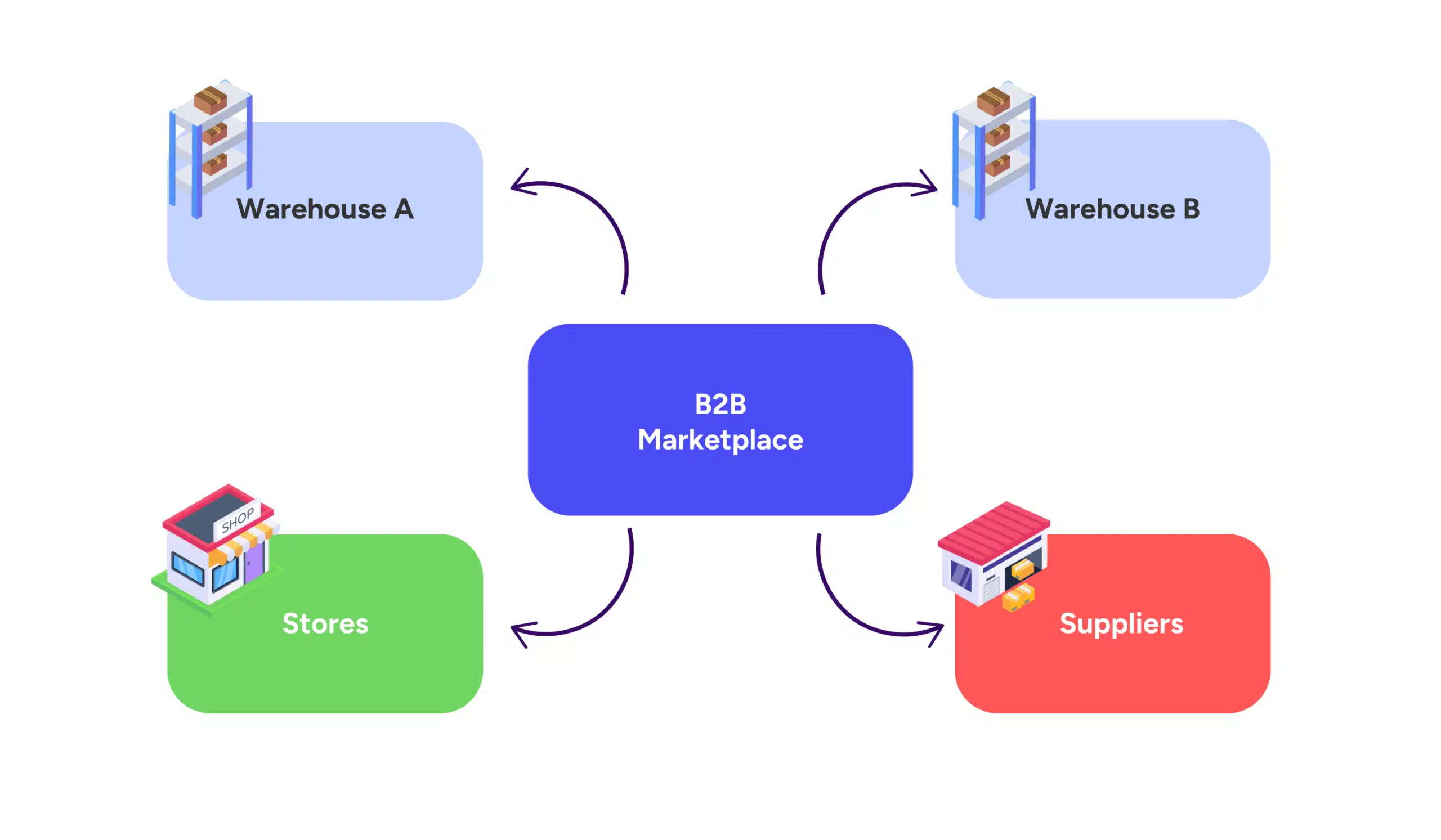Improve your Warehouse Management with a B2B Marketplace
- Arnaud
- 7 minutes reading

Warehouse management has evolved far beyond basic receiving and shipping operations. With the rise of digital transactions, fulfillment and inventory management have become strategic essentials for meeting the expectations of professional buyers. Discover how a B2B marketplace can transform and optimize these processes, providing significant gains in efficiency and competitiveness to improve your warehouse management.
- How can a B2B marketplace improve your warehouse management?
- The strategic importance of fulfillment management
- The benefits of optimized warehouse management
- Integrating predictive stock management
- Multi-warehouse management to streamline storage and reduce costs
- Responsible and sustainable warehouse management
- Enhanced collaboration with logistics partners and suppliers
- Optimize your business processes with a high-performance warehouse management system
👋 No time to read the entire article? Find the summary here.
1. How can a B2B marketplace improve your warehouse management?
A B2B marketplace centralizes and streamlines stock management, fulfillment, and logistics operations, enabling better coordination and efficiency at every stage, helping you improve your warehouse management:
- Receiving and storing products: With centralized inventory management, including the ability to manage multiple warehouses, the supply chain becomes more seamless and efficient.
- Order preparation for shipping: Automation tools allow for faster and more accurate order processing, ensuring timely deliveries.
- Managing returns: A B2B marketplace facilitates return management and centralizes exchanges, speeding up the handling of disputes and refunds.
Providing effective tools for your vendors reduces logistics costs, optimizes management processes, and ultimately improves customer satisfaction. This is yet another way a B2B marketplace can help you improve your warehouse management.
“One of the main advantages of a B2B marketplace is data centralization. By integrating such a solution, you gain real-time access to your inventory status, enabling you to better anticipate demand and avoid overstock or shortages. This means less unnecessary storage costs and better product availability for your customers.”

Alexandre Duquenoy
→ Connect with our B2B solutions expert.
2. The strategic importance of fulfillment management
B2B orders are often complex and large-scale, making logistics challenging. As a result, vendors may wish to delegate supply chain management to improve your warehouse management and:
- Reduce or eliminate storage costs
- Ensure product availability
- Meet delivery deadlines
- Simplify returns processing
By offering fulfillment services, you mitigate the following risks:
- Delivery delays: Poor organization can slow down shipments, harming customer satisfaction.
- Order preparation errors: Poorly managed stock can lead to costly mistakes, such as incorrect product shipments.
- Dissatisfied customers: Delays and errors negatively impact brand image and customer loyalty.
Download our free requirement specification template
Access essential functionalities to successfully build your C2C, B2C, or B2B marketplace. This simple-to-use backlog template will support you at every project stage.
3. The benefits of optimized warehouse management
Optimizing warehouse management through a B2B marketplace solution is a crucial step to improve your warehouse management, providing numerous benefits:
- Cost reduction: Accurate inventory management helps avoid overstock and shortages, optimizing space and storage costs.
- Improved customer satisfaction: Faster deliveries through multi-warehouse and automated order management enhance customer loyalty.
- Real-time performance tracking: Key performance indicators (KPIs) quickly identify bottlenecks and optimize operations.
4. Integrating predictive stock management
Predictive analysis is an asset for anticipating and adapting to demand fluctuations. By relying on historical data, companies can improve their warehouse management and:
- Predict demand fluctuations and adjust their inventory to avoid excess or shortages.
- Optimize supply to reduce overstocking costs while ensuring product availability.
- Minimize losses through better replenishment management and adaptation to future needs.
5. Multi-warehouse management to streamline storage and reduce costs
For large B2B platforms, multi-warehouse management offers several advantages, which directly help improve your warehouse management:
- Reduced delivery times: Distributing inventory across multiple warehouses brings products closer to end customers.
- Lower logistics costs: Choosing the warehouse closest to the customer reduces transportation costs.
- Effective demand peak management: Distributing volumes across different sites helps absorb demand spikes without bottlenecks.
A multi-warehouse management system (WMS) centralizes information and smooths out shipments.

“Multi-warehouse management is a major asset of a B2B marketplace. By distributing your inventory across multiple strategic sites, you can reduce delivery times and optimize logistics costs. It’s also possible to link your store network or suppliers directly. This way, your customers receive their orders faster, increasing their satisfaction and loyalty.”

Antoine Mantel
→ Connect with our B2B solutions expert.
6. Responsible and sustainable warehouse management
With growing environmental concerns, adopting more sustainable management practices is a competitive advantage that can also improve your warehouse management:
- Optimizing delivery routes: Better logistics planning reduces unnecessary trips and the carbon footprint.
- Reducing waste: Using reusable or recyclable packaging reduces packaging waste.
- Improving energy efficiency: Solutions like LED lighting and better insulation lower warehouse energy costs.
- Geolocalized distribution: Offering suppliers based on the client’s geographic location minimizes travel distances.
These practices benefit both the environment and the company’s finances, further enhancing the ability to improve your warehouse management.
7. Enhanced collaboration with logistics partners and suppliers
A B2B marketplace facilitates cooperation among logistics partners and suppliers through better data synchronization, which can improve your warehouse management:
- Real-time data exchange to synchronize stock levels and avoid shortages.
- Carrier integration into the platform to ensure precise delivery tracking and improved deadline adherence.
Operators gain a centralized view of all this information, quickly identifying potential obstacles for vendors.
“Automation is the key to efficiency. With a B2B marketplace, you can automate order, return, and replenishment management, reducing human errors and operational costs. A smooth return process, for example, enhances customer trust in your ability to resolve disputes quickly.”

Alexandre Duquenoy
→ Connect with our B2B solutions expert.
8. Optimize your business processes with a high-performance warehouse management system
Integrating a high-performance warehouse management system relies on digital tools capable of synchronizing inventory in real-time, helping you continually improve your warehouse management. Key features of a marketplace solution include:
- Automated stock management: Automation reduces human errors.
- Real-time shipment tracking: Providing precise delivery tracking improves customer experience.
- Simplified return management: Automating returns handling ensures better customer satisfaction.
To improve your warehouse management and fulfillment processes, implementing a B2B marketplace should be at the heart of your strategy. By adopting advanced digital solutions, predictive technologies, and sustainable practices, you enhance operational efficiency, reduce costs, and optimize customer experience.
Discover how Origami Marketplace can help you create a custom B2B marketplace or explore other articles, such as quote management or volume pricing, to go further. If you wish to discuss this topic or your professional needs, our team is at your disposal.
Key takeaways:
- Centralization and automation: A B2B marketplace optimizes stock management, fulfillment, and logistics by centralizing and automating operations, helping you improve your warehouse management.
- Efficiency and cost reduction: It reduces overstock, logistics costs, and guarantees fast deliveries, improving customer satisfaction.
- Predictive and multi-warehouse management: Anticipate demand, optimize supply, and facilitate multi-warehouse management to reduce delivery times and transport costs.
- Sustainability and collaboration: Promotes more sustainable logistics practices and enhances partner collaboration through better data synchronization.
Discover how the Origami Marketplace API and its partner network can transform your business, regardless of its size, with its innovative marketplace model.



